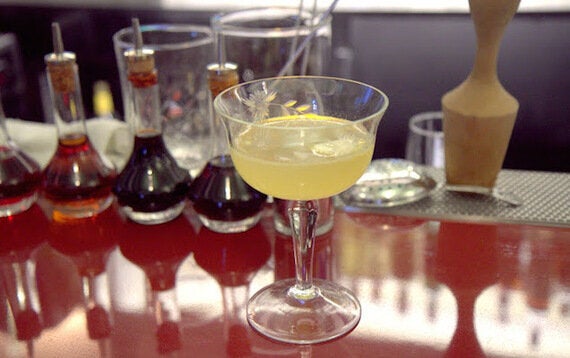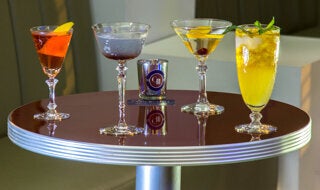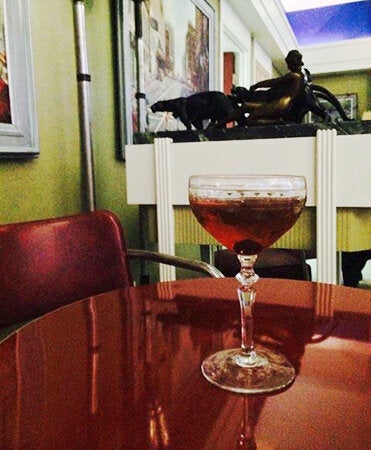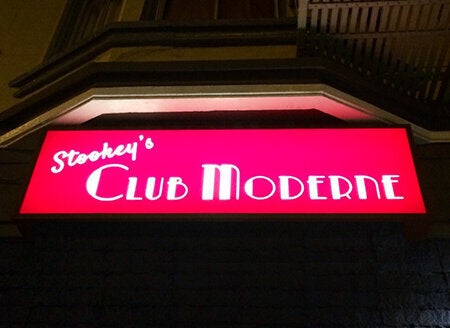
On a recent trip to San Francisco I had the pleasure of visiting a most intriguing cocktail bar run by a Mr Timothy Snookey, a veteran of the City's bar scene. Tim now runs the excellently styled Stookey's Club Moderne in the center of town and before I drank myself into a coma one evening I suggested he might want to fill me in about all this cocktail business, old-school style.
Which he totally did!
All answers Timothy Snookey.
What the history of the cocktail to you?
It is safe to say that the "Cocktail" was created around 1800 in either Britain or the United States. Whether Britain or the U.S. claims the original invention, it is clear that the development of the cocktail flourished in the United States. A steady increase in popularity took between 1800 and 1860. Examples of cocktail creations during this period include the Sazerac and the Sherry Cobbler. From 1860 to 1890, the cocktail developed along with increased trade with Europe and new ingredients were introduced into the bartenders' toolkit. Examples include such classics as the Manhattan and the Martinez/Martini which are impossible to make without imported vermouth. The first famous bartender, Jerry Thomas, also wrote the first official book (The Bar-Tender's Guide, 1862) on the art of bar-tending that included published cocktail recipes.
The 1890s - 1920 is seen as a Golden Age of cocktail making. Recipes grew more complex with the addition of fresh citrus (which was more readily available). Examples include the Daiquiri, Whiskey Sour, the Aviation and at the onset of Prohibition in the U.S., the Last Word.
With the onset of Prohibition in the U.S. in the 1920s, cocktail culture radically changed and went underground. With the increasing scarcity of good quality alcohol, and cheap, poorly made alcohol taking its place, recipes during this time relied more or sweeteners and fruit juice to mask the offending flavors of bad booze.

During prohibition, millions of gallons of existing whiskey was held under government control and could only be sold in pharmacies with a doctor's prescription. After Repeal in 1933, there was an obvious shortage of American produced whiskeys. Because of this, a new category of whiskey was invented: blended whiskey (20% straight whiskey was combined with 80% grained neutral spirits). The Highball cocktail made the inferior spirit combination more palatable.
During the war years, because of rationing and restriction, liquor production took a back seat to the war effort. With the exception of the category of "tropical" drinks -- the Mai Tai was a key example. It was a lot easier to obtain rum than whiskey or scotch. After the war the "big" liquor companies and distilleries (e.g. Seagrams, Bacardi, etc) were driving the cocktail culture. These large corporations published recipe books that pushed their specific brands. The post-war real estate boom and sleek mid-century modern subdivisions featured "the home bar" (wet bars). Now one could easily buy a favorite brand in the neighborhood super market. The art of professional bar-tending was on the wane.
And things wouldn't really change until the mid 1990s. The culinary explosion pushed cocktail culture to reexamine itself and its past. Epicurean sensibilities allowed for new interpretations of the classics. Fresh ingredients and the flavor pairings became increasingly important. Similarly, harder to find spirits became more easily accessible, and on-line research possibilities continued to develop.

Why is post-prohibition cocktail making so important to you?
I have always been interested in this period in time. This is one of the last great periods in cocktail making before the present. This era is filled with many cultural changes that affected the drinking culture. In 1920 women were voting and then subsequently became part of the very public drinking culture. Also the environment of the saloon morphed into the speakeasy which then became the cocktail lounge and supper/night club where one would go to drink, dress up and hear sophisticated jazz bands and big band orchestras. The importance of stream-lined design and the growing importance of transportation methods (aviation) were also influential. Finally, this era revived many of the classic cocktails of the pre-prohibition era, yet many new cocktails were being created (examples include the 20th Century and the Mai Tai that had complex flavor profiles and alluded to exotic locales.
How do you make the perfect martini?
I like a 4 part gin to 1 part dry vermouth combination. I prefer a London dry gin (Boodles, Beefeater, etc). Always stirred over ice, strained and garnished with olive or lemon peel. Because of the tendency in today's culture to "supersize" everything, attention should be made to the proper proportions. This drink should not be more than three ounces (including diluted ice).
Is there is a standard formula for a cocktail or are they all unique?
Most cocktails have a similar formula. The formula is 1 ½ oz spirit, ¾ oz and/or modifier and ½ oz sweetener.
If you were to design a new cocktail, are there any rules you would follow?
Firstly I would consider the spirit and the strength of the spirit. Next I would look at possible modifiers (liqueur, vermouth, fruit juice, cream) that would work in combination. Usually those modifiers are roughly half the amount of the spirit. If a fruit juice is chosen, sweeteners must be considered. If you are using whiskey, then lemon is preferred over lime. If a gin is used, lemon or lime is used. If the drink is spirituous, then stirring is the preferred method of mixing. If fruit juice is present, shaking is the preferred method.
How important are ratios when making cocktails?
They are extremely important. It is the basis of all cocktails. Mixology is often an exact science. The chemistry is key - if the ratios are off, you run the risk of missing some of the subtlety in the finished cocktail's flavor combination.

---
If you're in San Francisco during these cold, winter months, Snookeys Club Moderne is at the corner of Bush and Taylor and is open 4:30PM till 2AM Monday - Sunday
All images copyright Stookey's Club Moderne, Zagat